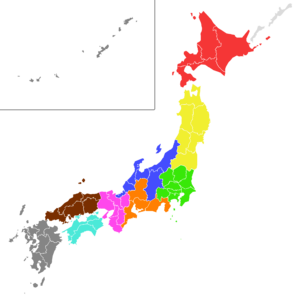Japanese Regional Leagues facts for kids
| Founded | 1966 (Kansai and Tokai) 1967 (Kanto) 1973 (Chugoku and Kyushu) 1975 (Hokushin'etsu) 1977 (Shikoku and Tohoku) 1978 (Hokkaido) |
|---|---|
| Country | Japan |
| Confederation | AFC (Asia) |
| Divisions | 5 (first level) 6 (second level) |
| Number of teams | 130 |
| Level on pyramid | 5–6 |
| Promotion to | Japan Soccer League (1966–1991) Japan Football League (1992–1998) Japan Football League (1999–present) |
| Relegation to | Japanese Prefectural Leagues |
| Domestic cup(s) | Emperor's Cup Shakaijin Cup |
The Japanese Regional Leagues (also known as Chiiki Rīgu) are football leagues in Japan. They are organized by different regions across the country. These leagues are important because they are the fifth and sixth levels of the Japanese association football league system. This means they are just below the main national league, the Japan Football League.
How the Leagues Work
Japan is split into nine different areas for football. Each area has its own regional league. These leagues help teams play against others close to them.
Moving Up and Down in Leagues
At the end of each year, the best teams from the regional leagues get a chance to move up. This happens in a special tournament called the Japanese Regional Football Champions League. Usually, the teams that win their regional league get to play in this tournament. Sometimes, other strong teams can also join.
Teams in these regional leagues also play in two big cup competitions:
- The All Japan Senior Football Championship: The winner of this cup can also get a spot in the promotion tournament.
- The Emperor's Cup: To play in this national cup, regional league clubs must first win a qualifying cup in their local area.
Season Length
Most regional leagues do not have many teams, usually around 10. This means their season is shorter than bigger leagues. They often have long breaks during the summer.
Teams That Started at the Top
Some famous Japanese football clubs never played in the regional leagues. They started at higher levels. Here are some examples:
These five teams were part of the original Japan Soccer League, which started in 1965.
Other teams that started higher include:
- Shimizu S-Pulse: This club became professional when the J. League started in 1992.
- Sagan Tosu: This team took over another club's spot in the former Japan Football League in 1997.
- Yokohama FC: This club joined the Japan Football League directly when it was formed in 1999.
- Kataller Toyama: This team was formed in 2008 by combining two other clubs.
- Kagoshima United FC: This club was formed in 2014 by combining two teams from the Kyushu League.
Teams That Moved Regions
Some clubs have moved their home base to different regions over time. For example:
- Kashima Antlers started in the Kansai region but moved to Kantō in 1975.
- Avispa Fukuoka was first in the Tōkai region but moved to Kyushu in 1994.
- Vissel Kobe began in the Chūgoku region but moved to Kansai in 1995.
Regional Leagues in 2025
There are nine regional leagues across Japan. Each league has different teams competing to win and move up.
Hokkaido Soccer League
This league is in the Hokkaido region.
Tohoku Member-of-Society Soccer League
This league covers the Tohoku region and has two divisions: Division 1 and Division 2 (North and South).
Kantō Soccer League
This league is in the Kantō region and also has two divisions: Division 1 and Division 2.
Hokushinetsu Football League
This league covers the Hokushinetsu region and has two divisions: Division 1 and Division 2.
Tōkai Soccer League
This league is in the Tōkai region and has two divisions: Division 1 and Division 2.
Kansai Soccer League
This league covers the Kansai region and has two divisions: Division 1 and Division 2.
Chūgoku Soccer League
This league is in the Chūgoku region.
Shikoku Soccer League
This league covers the Shikoku region.
Kyushu Soccer League
This league is in the Kyushu region.
See also
- Sport in Japan
- Football in Japan
- Women's football in Japan
- Football in Japan
- Japan Football Association (JFA)


